I have this unanswered question where I had this erroneous result query:
SELECT
t1.patient_id,
CONVERT(aes_decrypt(t4.patient_name_en, :encKey) USING utf8mb4) as patient_name_en,
min(t3.date_of_visit) as date_of_visit,
t2.diagnosis_name,
max(ifnull(t5.date_of_assessment, 'N/A')) as date_of_assessment,
ifnull(t5.assessment_result, 0) as assessment_result
FROM consultation t1
LEFT JOIN diagnosis t2
ON t1.diagnosis_id = t2.diagnosis_id
LEFT JOIN visit t3
ON t3.visit_id = t1.visit_id
LEFT JOIN patient t4
ON t4.patient_id = t3.patient_id
LEFT JOIN diabetes_assessment t5
ON t5.patient_id = t4.patient_id
WHERE
t2.diagnosis_name LIKE :diagName AND
t1.clinic_id = :cid AND
t3.visit_status=:visit_status
GROUP BY
t1.patient_id,
t2.diagnosis_name,
t3.date_of_visit
t4.patient_name_en,
t5.date_of_assessment
t5.assessment_result
ORDER BY t5.date_of_assessment DESC
Which gives me this result:
The new thing is that I tried the following query using sub query to loop through patient_id:
SELECT t1.patient_id,
CONVERT(aes_decrypt(t4.patient_name_en, 'key1') USING utf8mb4) as patient_name_en,
min(t3.date_of_visit) as date_of_visit,
t2.diagnosis_name,
max(ifnull(t5.date_of_assessment, 'N/A')) as date_of_assessment,
ifnull(t5.assessment_result, 0) as assessment_result
FROM consultation t1
LEFT JOIN diagnosis t2
ON t1.diagnosis_id = t2.diagnosis_id
LEFT JOIN visit t3
ON t3.visit_id = t1.visit_id
LEFT JOIN patient t4
ON t4.patient_id = t3.patient_id
LEFT JOIN diabetes_assessment t5
ON t5.patient_id = t4.patient_id
WHERE t1.patient_id IN
(SELECT t1.patient_id
FROM consultation t1
LEFT JOIN diagnosis t2 ON t1.diagnosis_id = t2.diagnosis_id
LEFT JOIN visit t3 ON t3.visit_id = t1.visit_id
LEFT JOIN patient t4 ON t4.patient_id = t3.patient_id
LEFT JOIN diabetes_assessment t5 ON t5.patient_id = t4.patient_id
WHERE t2.diagnosis_name LIKE '%Diabetes%' AND t1.clinic_id = '361'
AND t3.visit_status="Active"
GROUP BY t1.patient_id) AND
t2.diagnosis_name LIKE '%Diabetes%' AND t1.clinic_id = '361'
AND t3.visit_status="Active"
GROUP BY t1.patient_id, t5.date_of_assessment, t4.patient_name_en, t3.date_of_visit, t2.diagnosis_name, t5.assessment_result
ORDER BY t5.date_of_assessment DESC
And I've got the same result shown at the image above.
Here is the an sql fiddle about my problem
What I really want is to show only the following two rows which means group by patient_id.
And for few reasons, I cannot disable the only_full_group_by mode,because I read it may give some faulty result.
I tried to only group by patient_id in the fiddle and apparently it works properly because the fiddle has the only_full_group_by disabled.
What should I do ?
- Create a PHP solution where I break the query into 2, the first one is the sub query where I will get the IDs and then use the outer query in a
foreachto get a row for each ID using LIMIT 1 ? - Or disable the
only_full_group_by modewhich will affect my other queries in my application on different aspects ? - Create an sql stored procedure instead of the solution #1 ?

